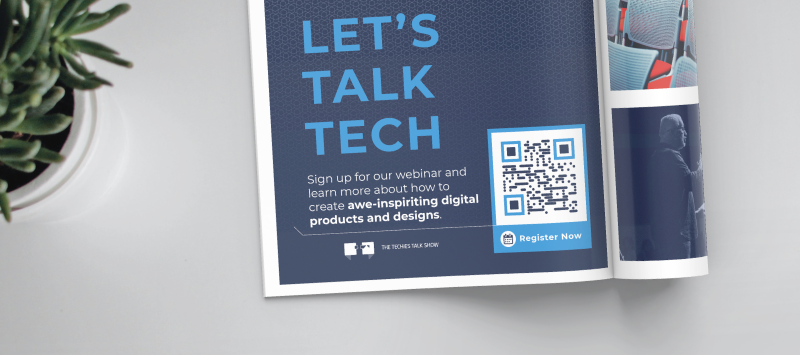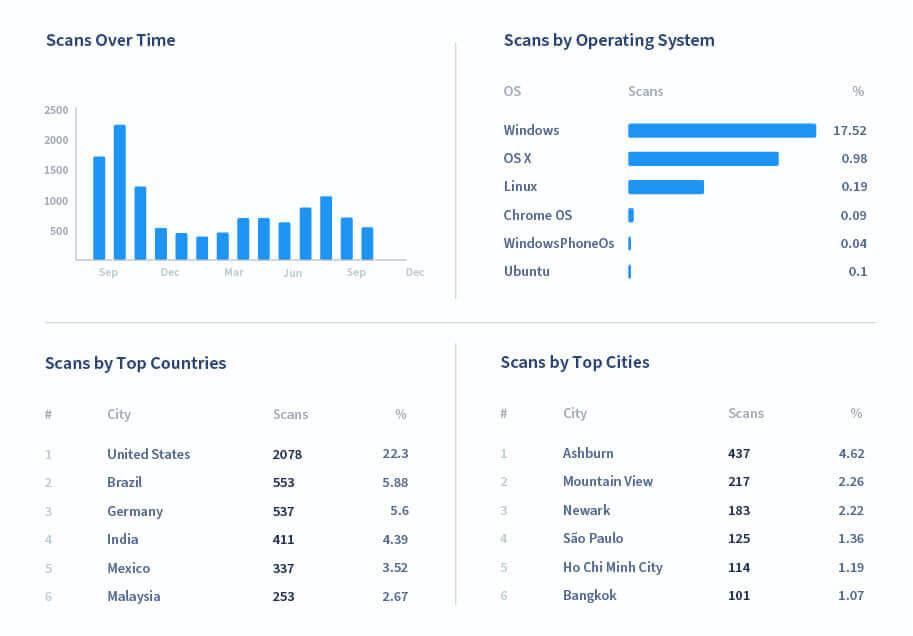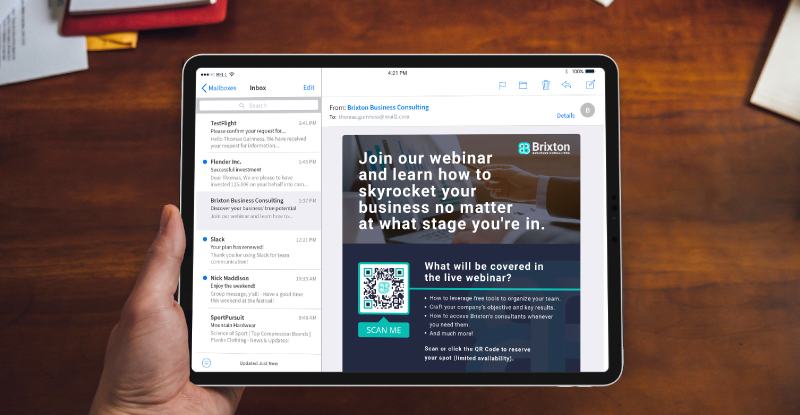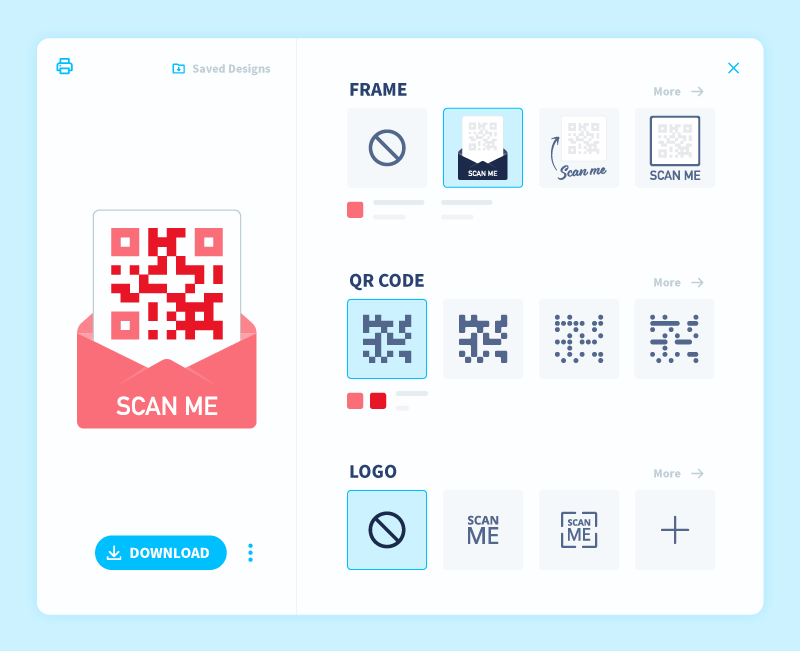- Best Practices ●
- COVID-19 ●
- Industry Trends ●
- Partners ●
- Product ●
Webinar Marketing: Your Complete Step-By-Step Strategy With QR Codes
Webinars have been trending as a B2B marketing strategy lately, and for good reason. These online seminars provide real value for potential customers, and they’re also an excellent lead generation opportunity. Webinars are also an opportunity to establish your brand as a trusted industry expert and build brand awareness.
QR Codes are a helpful tool for promoting your upcoming webinars. Rather than typing a long, complex link into their browser, attendees can scan a QR Code to sign up. Here’s how to create webinars that drive conversions, and how QR Codes in your digital marketing strategy can support that goal.
What is the point of webinar marketing?
Webinars are online video seminars on topics that are relevant to your target audience. These seminars can be held live or pre-recorded, depending on your marketing strategy.
Webinars are largely used as a form of B2B lead generation. When users register for the webinar, they subscribe to your company’s email marketing list, which pulls them into your sales funnel for future follow-up emails. Ideally, these new leads will eventually become customers.
This strategy has proven to be highly effective. Webinars are a good way for your brand to build trust with your audience. In a 2022 study, 58% of content marketers said that webinars were the most effective form of content marketing for their brand that year.
Hosting frequent webinars is an opportunity to attract more quality leads and build a strong brand identity. The key is to choose topics that address your audience’s pain points and ensure that each webinar provides real value for your audience.
Why your webinar marketing campaign should include QR Codes
QR Codes make it easy for interested webinar attendees to sign up for the event. You can use QR Codes across a wide range of marketing channels to capture a broader audience.
Trackable on print ads

QR Codes help connect your print ads to digital content. When using magazine ads, flyers, or other print marketing materials to promote your webinar, include a QR Code linking to the digital signup page via URL. Users can sign up for the webinar quickly with a simple scan, rather than having to look up the link separately.
Transparent ROI calculations with tracking metrics

Dynamic QR Codes come with advanced tracking and analytics features. You can monitor the number of scans your QR Code gets, the location of the scan, and the device used.
With these metrics available at your fingertips, you can easily calculate ROI for your webinar marketing campaigns when used in conjunction with other analytics tools like Google Analytics. You’ll be able to determine which advertising and marketing tactics generate the most QR scans. You can also compare the number of QR scans to the total number of webinar attendees to further assess the efficacy of your marketing campaigns.
Multi-channel marketing

QR Codes fit seamlessly into a multi-channel marketing strategy. In addition to using QR Codes on print ads, you can also use them in your digital marketing strategy. For example, you can place your QR Codes in your email campaigns and social media posts so users can easily screenshot and share them. You can also use QR Codes on billboards, signs, and business cards linking to webinar signups.
This option gives users the option to view your webinar information on the device that’s most convenient for them. For example, if they receive an email about your webinar with a QR Code on their desktop browser, they can scan it with their mobile device to sign up for the webinar there.
Perfect brand sync

Dynamic QR Codes are fully customizable, so they fit in perfectly with your existing brand assets. You can customize the QR Code’s colors and patterns to suit your brand’s style and match the rest of your marketing content. You can also add your logo and a call to action to the QR Code to make it even more cohesive and eye-catching.
The result is a QR Code that looks sleek and professional. It will support the rest of your marketing plan and drive more signups to your registration page.
Always editable
Another key benefit of Dynamic QR Codes is that you can always edit them later. You can switch the link attached to the QR Code at any time without having to change the design. You can even switch the type of media you’re linking to—for example, you can swap out a social media link for a web page link.
This is particularly helpful for brands that host webinars frequently. You can link to a new webinar landing page for each event without having to change the QR Code you’re using. This also means you’ll spend less time redoing your marketing assets each time you launch a new webinar!
How to create a webinar marketing strategy with QR Codes in 6 steps
Once you’ve decided to create webinar content for your brand, the next step is to create an effective webinar promotion strategy. QR Codes will support you in getting the word out about your upcoming webinar presentation and can help get your attendance rate up.
Here’s how to build your webinar marketing strategy using QR Codes in six easy steps.
1. Decide on a topic
The first step is to choose a webinar topic that will resonate with your audience. People attend webinars in order to learn new information, so the topic you choose should be something with obvious benefits for your attendees. It’s also an opportunity to demonstrate your thought leadership on a specific topic.
For example, many successful webinars serve as a how-to guide on an exciting new technology or skill.
Let’s say your brand is launching a new digital productivity tool. In this case, your webinar could be a how-to guide on various productivity strategies and include a segment on how to use the tool. Another popular webinar idea is a Q&A session with successful figures in your industry. This allows attendees to interact directly with experts, which immediately makes your webinar more appealing.
Choosing the right topic for these virtual events is a balancing act. You’ll want to appeal to a relatively wide audience, so the topic can’t be too complex or too niche.
However, if the topic is too broad, it will be difficult to cover it in full and provide truly valuable information. You’ll need to find the right balance to attract attendees and turn those attendees into future sales leads.
While business-focused webinars are particularly popular, don’t be afraid to branch out and cover other topics. In a recent study, 27% of respondents indicated that they would be most likely to sign up for a webinar that taught them about a hobby or passion.
If you’re not sure which topics to cover, try conducting a survey or interacting with your followers on social media to see which concepts they are interested in. You can even use QR Codes to link from your social media to a detailed feedback landing page.
2. Set up supporting tools
Once you’ve decided on a topic, you’ll need to identify a suitable webinar platform, as well as other tools to promote the event. You’ll also need a way to capture leads for future email campaigns and other marketing efforts.
Marketing automation tools like CRM software can make this process easier. Start by creating a webinar registration landing page with all the details about the event. Share this landing page using lead magnet QR Codes on your print marketing and social media. This way, your audience can sign up quickly by scanning the code with their mobile device.
Make sure your landing page can collect attendee email addresses so you can send relevant follow-up emails. You should also opt for a marketing tool that can create ads for the webinar.
You’ll also need to choose a tool to host your webinar. You’ll want to make sure the tool has the features you need, whether that’s live video, screen sharing, advanced audio, or audience participation features.
3. Plan your webinar event
Once you’ve decided which tools you want to use, it’s time to plan your webinar. Decide whether you’d like to launch a live webinar or an on-demand webinar. If you’re launching a live webinar, choose a date and time that makes sense for your target audience given their time zones. Consider the day of the week as well—Wednesdays and Thursdays are generally the most effective days to host a webinar. Confirm the schedule with your presenters to make sure they’re available. Give them plenty of time to prepare.
Launch your landing page with all of the relevant information for the event. Now’s also the time to create your QR Code for the signup page. Be sure to customize it with your logo and colors and test it on multiple devices to make sure it works properly. The signup process should be quick and easy for your audience.
4. Begin webinar promotion
Once you have all the marketing assets in place for your webinar, it’s time to start promoting it. Launch your webinar ads and activate the associated QR Codes.
Social media is one of the best places to get the word out about your webinar. LinkedIn is a particularly great platform for sharing these events. Industry-specific newsletters and publications can also be very effective places to promote your event and connect with your target audience.
5. Follow up with viewers afterward
After your webinar, be sure to stay in touch with your attendees and cultivate those relationships. Start by using Feedback QR Codes to collect feedback from attendees about their experiences. This information will help you improve your future webinars, and it also shows your attendees how much you value their input.
You should also put your attendees on a specific email list to keep in touch with them on an ongoing basis. Be sure to let them know in advance about future webinars and give them the opportunity to sign up early.
6. Track and analyze performance
After your webinar, use tracking and analytics tools to determine which of your advertising methods were most effective. For example, you can use QR Code analytics to determine which of your promotion methods led to the most signups.
How does QR Code tracking work? With QR Code analytics, you can see the number of scans each code receives, as well as the location of the scan and the device used. You can use this alongside other third-party data to correlate scan patterns with webinar signups to see which promotion methods generated the most attendees.
After the webinar, you can use email analytics to see which attendees stayed in touch with your brand and even moved through the sales funnel. If your webinar resulted in a spike in email signups, social media follows, or even sales queries, that’s an indication that the content was highly effective.
Plan and promote a successful webinar with QR Code Generator PRO
Webinar marketing is a win-win situation: Attendees learn valuable new information, and your sales team generates new qualified leads in the process. QR Codes are a hugely valuable tool for promoting your webinars. By implementing QR Codes in your webinar advertisements, you make it easy for interested attendees to sign up right away.
With QR Code Generator PRO, you can create custom Dynamic QR Codes for your upcoming webinars. QR Code Generator PRO gives your business access to a host of specific QR Code tools for every purpose. Whether you want to promote your webinar via social media, print ads, or email newsletters, it’s easy to create engaging branded codes with QR Code Generator PRO.




